Why Learn How to Draw Different Noses
If you haven’t figured it out by now, every person is unique and that includes their face and features and we should celebrate this. To do this correctly, we need to capture those differences, so in this post, we will be talking about how to achieve drawing different noses. If this is your first time drawing a nose, take some time to read this article and learn the basics here.
In this article, you’ll learn:
- Female Nose
- Male Nose
- Different Nose Shapes
Male Noses vs Female Noses - Difference in Drawing Nose: Width
The first major difference between male and female noses is the width.
When looking straight on a person’s face, the nose tends to sit just above the lower fourth of the face. It sits centered on the face, and the main thing to take note of is the width. For more on the subject, read our post about drawing face proportions.
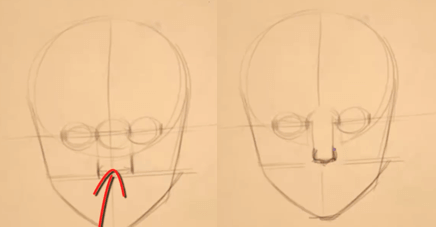
Male and Female Noses
The best measuring tool is the width of the eye. Generally speaking the distance between the eyes is about one eye length apart. It is common for the nose to also be about one eye length wide, although there are exceptions.
For instance, the male nose tends to extend just past the one eye length causing it to be slightly broader than this measurement.
On the other hand, the female nose tends to be a bit thinner than the male nose. So, in some cases, you can take that spacing of one eye width and reduce it slightly to give you a good proportion to use for the female noses
It should also be noted that a man’s nose is much more angular so from the front the male nose will be blocky with harsher lines. Women tend to have rounder and softer noses with softer lines.
Difference in Drawing Noses: Length
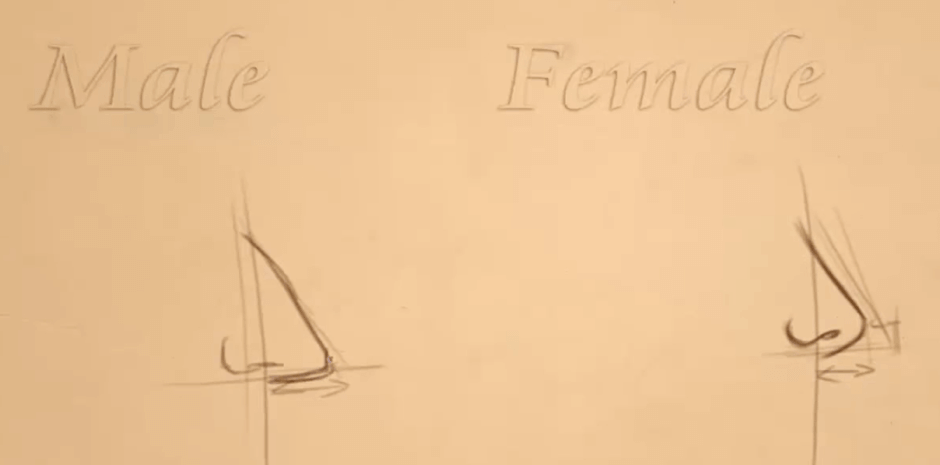
If we now turn the face to the side now, we would be looking at the length of the nose. There are drastic differences here, so they need to be noted.
Male noses are quite different compared to the female. More often than not, male noses will be larger than the female. So as in width, the length will also be greater.
Another change is the shape and curve of the ball of the nose. Women tend to be more upturned, while the male will have a flat or turned down effect to it.
It is also common for male noses to once again be blocky, so the ball of the nose will have corners as opposed to a woman, whose noses are normally softer and less well defined.
The Third Difference: Treatment
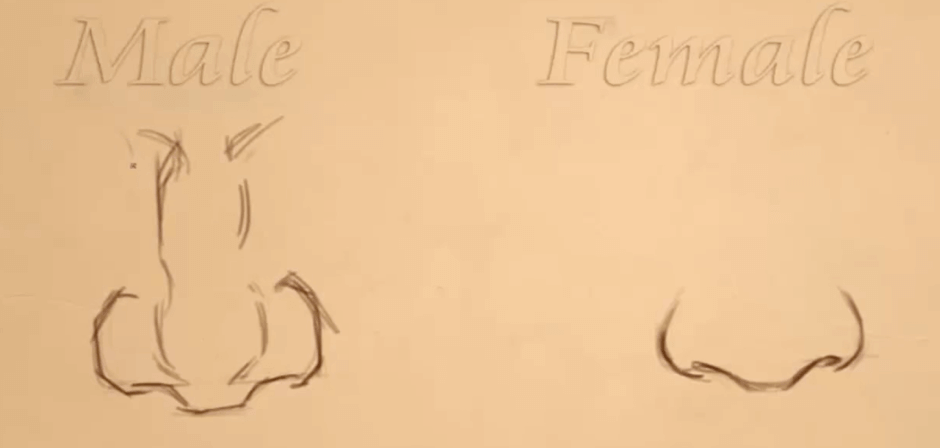
Differences between men and women’s noses does not stop at changes in size, but in their execution as well. We mentioned already the male noses tend to be blocky and women rounded, but the act of drawing the nose needs to change.
For example, the lines used for the male nose should be darker, more defined and chiseled. Female noses need to be less defined, soft, and round.
You can exaggerate the shape and form on men. It’s macho and manly. Women need cute noses that are softly drawn with light lines, just an indication of their form.
The Fourth Difference: Shading the Nose
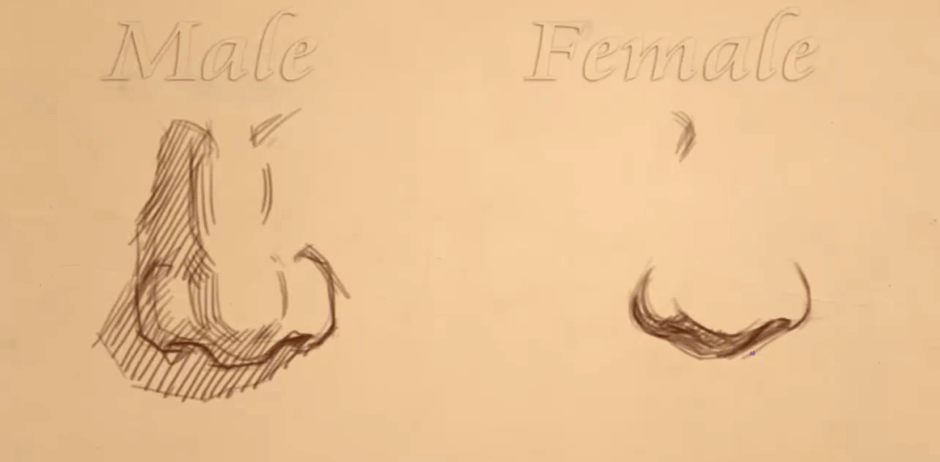
Here again you can see that the male nose receives much more attention with bold choices and strong definition.
The shading for a woman should be understated. Soft, delicate.
All of these various points help to enhance the strength of your male characters and the delicate nature of your females.
One of the things that you can do when you are practicing and creating your own explorations of nose drawing is to try and draw a side by side comparison of a female nose using soft shading, and another nose that uses more deliberate shading like in the example above.
You could also try to use more angular lines on your female character with soft shading to mix and match the different style elements and see what you can come up with.
Just like you can learn in our post how to draw the male and female mouth, the differences are quite stark. Only this time it is flipped, males need less definition in their lips than women do. These little tricks will help convince your viewer of what they are looking at.
The only reason you would stray from these generalizations would be to create ambiguity – if you wish to do so.
ASSIGNMENT
Draw and study these ideas, doing 50 renditions of both male and female noses. Look at them in different angles and lighting to explore the ideas. You can also mix and match to see what comes of it.
TIP: Sometimes failure is good. It’s important to know not only what is right, but also what is wrong – or how not to do things. Each failure is a step in the right direction because you now know what to avoid.
Doing repetitious studies in quick succession you will create a pallet of right and wrong ways to draw something that you can refer back to in the future.
How to Draw Different Nose Shapes: The Basics
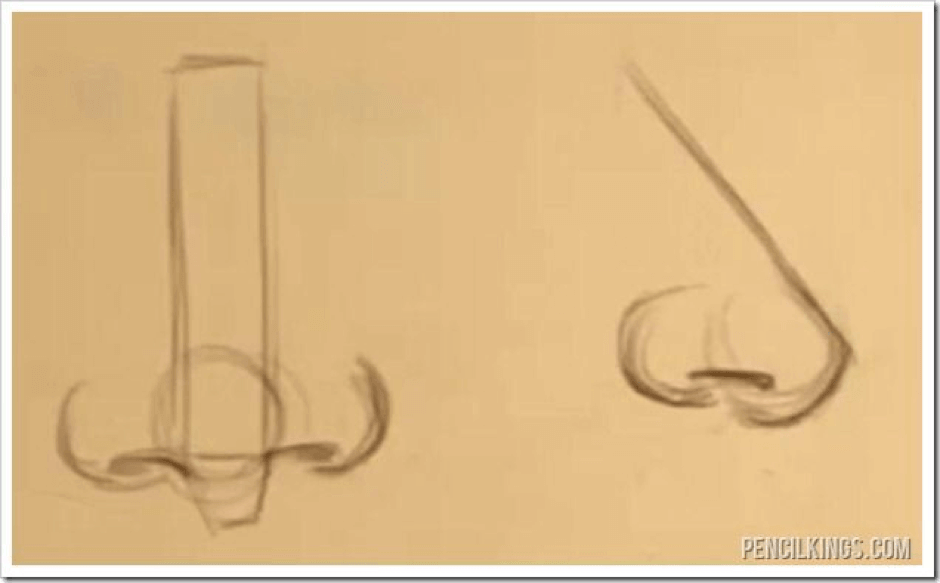
The brow bone joins the nose to the face
To learn how to draw different nose shapes, you must first be familiar with how to draw the nose. Here we will build on those basic forms or ideas in order to explore even more possibilities.
Remember, the nose is made up of these four basic parts:
- The Bridge
- The Septum
- The Ball
- The Nostrils
Now that you have a basic understanding of how a nose is drawn, you can manipulate these four basic building blocks to learn how to draw different nose shapes!
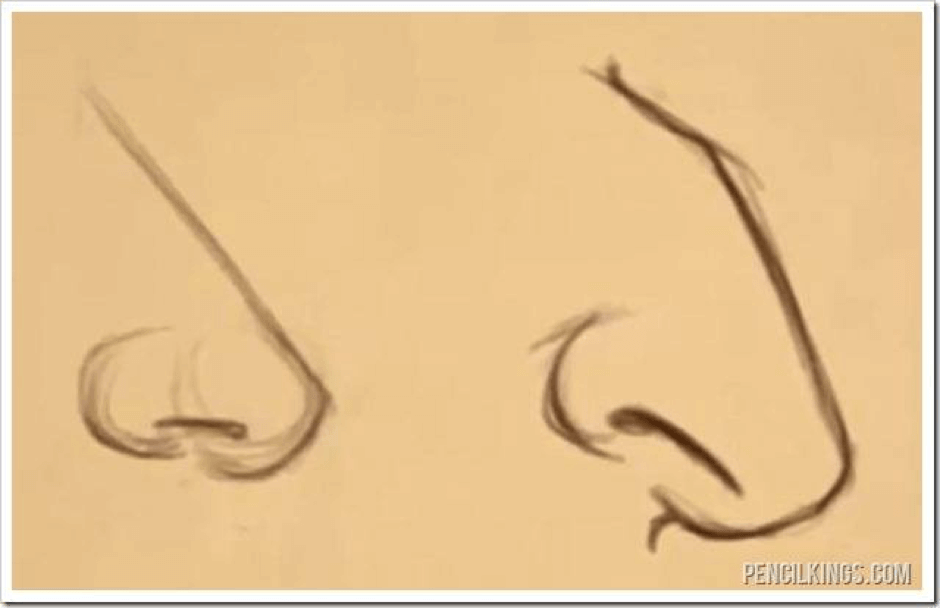
Surface direction lines are useful for shading
Changing the Basic Shapes
The first thing we need to understand is that every aspect of the four individual shapes, bridge, septum, ball, and nostril can be changed – and in drastic ways.
You can play with size – how wide, how long, how short, how round – placement – how high, how low – even in the angles you use – flat, up, down, sideways and upside down – and in thousands of different combinations.
It’s amazing then how little people take advantage of the option to create amazing and unique characters, but now while you are working on your characters and concepts, you will succeed in creating things in dynamic and new ways.
Above is a great example of drastic changes – the bridge has been elevated and has been given an angle. The ball of the nose turns downward and droops down a lot. The angle of the wings has been exaggerated greatly and the nostril follows suit.
Overall the nose is larger and more defined – indicating that the owner of this nose is older than the first example, and is exceedingly more male – although the first is not particularly feminine, it is more of a generic nose that could be pushed to go either way.
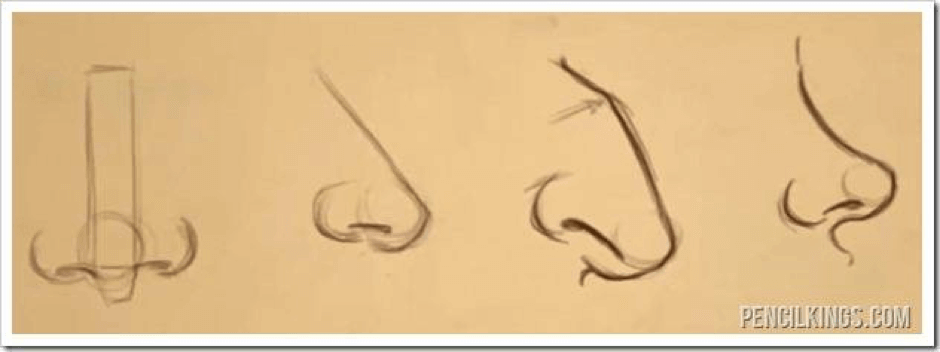
Side View Nose Drawing Variations
The best way to explore your options will be in the profile view. As you can see some of the more drastic changes must be viewed from the side. Our first two examples from before are now aligned with an additional nose, which is decidedly more female.
Here the bridge has been nipped so that her nose is less defined and softer. The ball of the nose is smaller and points upward. The angle of the wings and nostril is upward as well.
Overall, this nose looks like it belongs to a rather young female and is much perkier than the first nose which – If you used to for a woman, would appear to be older. She would not be described as cute but more striking. – Describing a strong woman with a lot of character.
Additional Nose Drawings

Here are two additional ways in which you could change up the features to create something quite unique, a grumpy old man. Okay, grumpy old men aren’t exactly unicorns, but we’ve really pushed it.
The nose is short, bulbous, droopy and in more ways than one – and does a great job of telling us what type of character we are looking at.
Now go forth and explore! Take the time to play and it will pay!
ASSIGNMENT
Go out and find pictures of people that you may or may not know. Like famous people, your family, friends. Chances are you haven’t really noticed anything strange or weird about their particular noses but if you start looking, you might just find things aren’t as status quo as you may have thought.
Using the evidence you’ve collected so far draw out 50 unique, or unusual combination of noses. Have fun with this, and go crazy!
